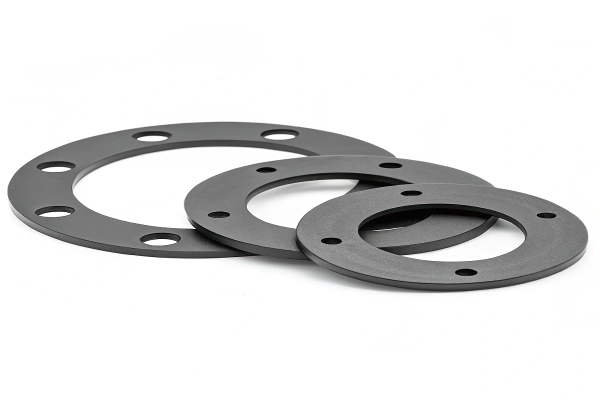Selecting the wrong rubber material for gaskets can lead to leaks, equipment failure, and costly downtime. As a gasket manufacturer with years of experience, I understand how critical material selection is for ensuring optimal performance. But what exactly is the best rubber material for gaskets?
The best rubber materials for gaskets typically include EPDM, Nitrile (NBR), Silicone, and Viton®. The choice depends on specific applications, temperature ranges, chemical compatibility, and environmental conditions.

Choosing the right rubber ensures reliable sealing, prevents leakage, and significantly reduces maintenance issues. Let's dive deeper into each type of rubber gasket material.
EPDM Rubber for Gaskets: Is it the Best Choice?
If you've ever faced issues with gasket failure due to weathering or water exposure, you're probably looking for a solution that can withstand these conditions effectively.
EPDM (Ethylene Propylene Diene Monomer) rubber is best suited for gaskets exposed to outdoor weathering, UV radiation, ozone, steam, and water. It's widely considered the best rubber gasket material for environmental sealing.
Why Choose EPDM?
- Excellent Weathering Resistance: EPDM1 remains flexible and durable in harsh weather conditions, outperforming most other rubbers.
- Great Thermal Stability: Operates reliably between -50°C and +150°C.
- Cost-Effective: Offers strong performance at a relatively low cost.
Applications of EPDM Gaskets
- HVAC systems
- Automotive sealing
- Water and wastewater handling
- Roofing and window seals
Limitations of EPDM Rubber
However, EPDM has poor compatibility with petroleum oils and fuels, limiting its use in these environments. It's essential to ensure your application does not involve direct contact with hydrocarbon-based fluids.
Nitrile (NBR)2 Rubber for Gaskets: When is it Ideal?
Have you experienced gasket failures in oil-based environments? Such leaks can quickly escalate into costly repairs and downtime.
Nitrile rubber (NBR) is the ideal gasket material for applications involving oils, fuels, and petroleum-based products. It has superior resistance to hydrocarbons, oils, and solvents.

Advantages of Nitrile Gaskets
- Outstanding Oil Resistance: Provides a reliable seal in contact with oils and fuels.
- Good Abrasion Resistance: Suitable for dynamic applications.
- Wide Temperature Range: Typically between -30°C and +120°C.
Common Applications
- Automotive fuel systems
- Oil seals
- Hydraulic system seals
- Industrial equipment handling oils and greases
NBR Limitations
Nitrile rubber is sensitive to ozone, sunlight, and weathering. Hence, it's not ideal for prolonged outdoor applications without additional protective measures.
Silicone Rubber for Gaskets: When Should You Use It?
If you're struggling with gasket degradation under extreme temperatures or requiring FDA compliance, silicone rubber could be your answer.
Silicone rubber offers exceptional temperature resistance, maintaining flexibility and sealing effectiveness from -60°C to +230°C. It’s also food-safe, making it suitable for medical and food-grade applications.
Benefits of Silicone Rubber Gaskets
- Superior Thermal Stability: Performs reliably in extreme high and low temperatures.
- Food and Medical Grade: FDA-approved grades available, suitable for sensitive applications.
- Excellent Aging and UV Resistance: Remains stable over extended periods.
Silicone Rubber Gasket Applications
| Industry | Applications |
|---|---|
| Food & Beverage | Oven seals, cooking equipment |
| Medical | Sterilization equipment |
| Electronics | Protective seals, insulation |
| Automotive | High-temperature seals |
Limitations of Silicone Rubber
Silicone rubber has relatively poor tensile strength and limited resistance to petroleum-based oils and fuels, making it unsuitable for heavy mechanical stress or oil-contact applications.
Viton® (FKM)3 Rubber for Gaskets: Is it Worth the Cost?
Have you dealt with gasket failures in chemically aggressive or high-temperature environments? Viton® rubber might offer the durability you're seeking.
Viton® (Fluoroelastomer/FKM) is renowned for its excellent resistance to chemicals, oils, fuels, and extreme temperatures (up to +250°C). It is considered the premium gasket material for challenging environments.
Why Viton® is Premium
- Exceptional Chemical Resistance: Ideal for harsh chemicals, solvents, and aggressive media.
- High-Temperature Performance: Maintains integrity even under prolonged exposure to high temperatures.
- Long-Term Durability: Resists aging, ozone, UV exposure, and oxidation exceptionally well.
Ideal Applications of Viton® Gaskets
| Industry | Applications |
|---|---|
| Chemical Processing | Pumps, valves, chemical containers |
| Automotive | Fuel injector seals, turbochargers |
| Aerospace | Engine seals, fuel systems |
| Petroleum | Oil exploration and refining |
Drawbacks of Viton®
Viton® rubber is relatively costly compared to EPDM, NBR, and silicone. It's generally reserved for critical sealing applications where other rubbers cannot perform adequately.
Conclusion: Which Rubber is Best for Your Gaskets?
Ultimately, the best rubber for your gaskets depends on your specific application requirements:
- EPDM: Best for outdoor exposure, weather resistance, and water sealing.
- NBR: Optimal choice for oil and fuel resistance.
- Silicone: Ideal for extreme temperature conditions and food-grade applications.
- Viton® (FKM): Superior chemical resistance and high-temperature stability in aggressive environments.
Consider your application carefully—temperature ranges, chemical exposures, and mechanical stresses—before making a choice. Selecting the right gasket material can significantly improve your equipment's reliability and reduce operational costs.
-
Learn more about EPDM's weather resistance and durability, making it ideal for outdoor applications. ↩
-
Explore this link to understand why Nitrile (NBR) is the go-to choice for oil and fuel resistance in gaskets. ↩
-
Discover the exceptional chemical resistance and high-temperature performance of Viton® for critical sealing applications. ↩








